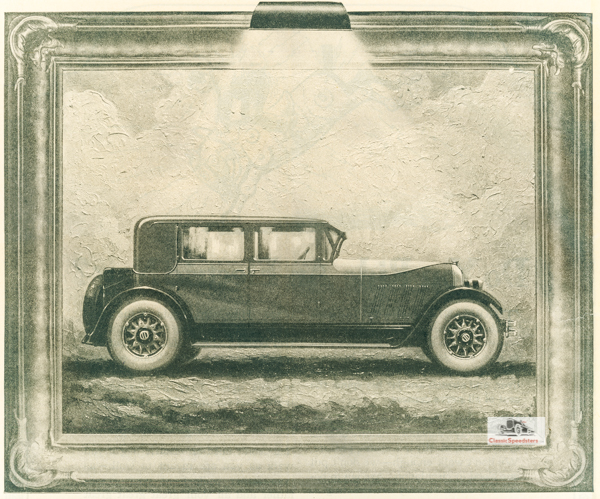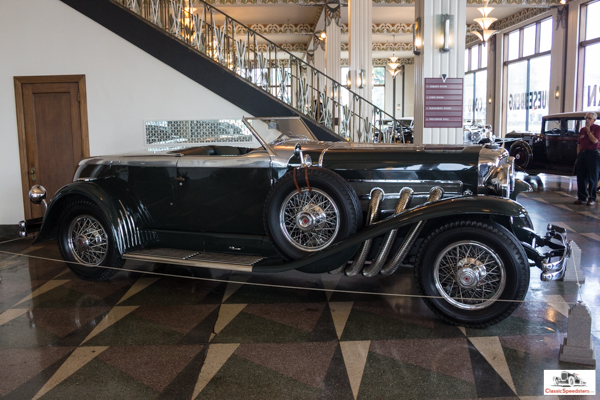Fans of Auburn, Cord, and Duesenberg automobiles know full well that Auburn and Duesenberg both had awesome versions of speedster models. Auburn produced their examples at the Connersville, Indiana plant, while Duesenberg manufactured their chassis in Indianapolis and offered these for sale, which also included the Duesenberg front face, consisting of radiator, lights, and fenders. The bodies were then completed by approved coachbuilders who referred to the Duesenberg catalog of bodies, but also listened to their clients, some of whom desiring a speedster body.
Auburn-Duesenberg Factories 1930
Because these cars were made during the height of the Coachbuilt Era and were influenced by both Art Deco and Bauhaus styling trends coming over from Europe, Auburns and Duesenbergs were right up there in styling. Their examples exemplified America’s (and Europe’s) leading-edge design statements regarding luxo speedsters, boulevardiers whose main purpose was to show that Who’s Who had arrived. In style.
Auburn Speedsters
Errett Lobban Cord, founder of the Cord Corporation
The nascent sports-bodied speedster movement was in full swing during the time that Errett Lobban Cord took over as general manager at Auburn in 1925. Auburn was sustaining itself during a mid-1920s resurgence in the economy but not nearly growing as the company should. Problem? The firm was run by a board chiefly made up of bankers. It needed a car guy to run the show.
E.L. Cord changed all of that, putting the Cord Automobile Company on the map and establishing an earnings trajectory that earned him the honor of being called “Man of the Year” twice by Time magazine. Cord was an automobile executive par excellence, and the empire that he created in 1925 would flourish for a good ten years before the Great Depression and subsequent Threadbare Thirties would drag it down, much like many other storied independent automakers that withered and died.
1925 Auburn Sedan. Illus courtesy AACA Library
Cord gave his designers the freedom to innovate in all of the model lines, and coupled with Cord’s powerful use of style to market his automobiles, it was inevitable that a speedster model would come forth from this collaboration between manager and design team. These were high times, Auburn was ascendant, and a speedster was jazzy news.
1928 was the first roll-out of an Auburn Speedster, and the Model 88 and Model 115 were their first examples. Over the course of the next several years, and in line with the company’s rise in fortunes, as well as their fall, some form of Auburn Speedster model would be offered up until nearly the end of company production in 1937.
1928 Auburn Speedster ad. Illus courtesy AACA Library
Famous designers such as Al Leamy and Gordon Buehrig made their mark on various Auburn Speedster models during successive model years. The last and probably most beautiful rendition was executed by Buehrig in 1934 at the behest of then head of Auburn, Harold Ames, who told Buehrig to recycle the unsold 1933 Salon Series Speedsters and make something new-looking to sell. Buehrig and his design team cobbled together bits and pieces for the front, made up a new taper tail for the rear, and voila! The 1935 Model 851 Supercharged Speedster emerged. And what didn’t sell in 1935 was rebadged as the 1936 Model 852. Tough times required tough measures, but what a beaut!
Despite the requirements placed on this model, it was anything but a bitsa car. An instant classic was created, one that commands the show field at any concours to this day.
1935 Auburn 851 Supercharged Speedster. Illus courtesy AACA Library
Duesenberg Speedsters
In 1926 EL Cord made an offer to purchase the floundering Duesenberg Automobile and Motors Corporation, a famous collaboration of two Duesenberg brothers who mainly built cars in order to fund their racing enterprise. Duesenberg engines were known for their stout performance and ability to outlast others on the track in whatever car they were placed. Too few Duesenberg street automobiles were produced to keep their company afloat, and so EL Cord stepped in and bought Duesenberg at a fire sale price.
The Duesenberg that EL Cord envisioned in 1926 would be the capstone of Cord’s three-tiered auto dynasty, with Auburn offered for the middle-class market, Cord (yet to be produced) for the well-to-do, and Duesenberg to be an exclusive conveyance, an over-the-top vehicle for those who wanted and could afford the best-looking and fastest American luxury car ever made.
The strategy was audacious but funds were pouring in from the sale of Auburns, and so plans were made, long nights with principals were spent at the kitchen table in the Cord residence planning this detail and that, which would be sent over to designer Al Leamy to incorporate. What emerged in 1930 was an automobile that was based on Cord’s vision and executed by shared resources in design and engineering.
1930-31 Duesenberg Catalog Custom Models
While Cord was in the process of purchasing Duesenberg, the brothers had been experimenting with a bridge design of automobile known as the Model X. A design executed by Johan (John) Tjaarda, the 1926-27 Model X Speedster was innovative and yet classic at the same time. Its lines, from the radiator cap back to the taper tail, all connected in a simple form that spoke movement and excitement. This model, though never mass-produced, inspired several others speedsters, including those made at Auburn and Stutz. Cord decided to keep the project alive and fold it into his development of the Model J Duesenberg.
1927 Duesenberg Model X Speedster
A projected run of 500 Model J chassis was planned, and detailed drawings of the chassis, along with the Al Leamy-designed Model J façade ( a requirement) and engine-drivetrain specs, were sent out to a small group of the principal coachbuilders of the period. This was how the Duesenberg Model J was initiated.
1930 Duesenberg Model J Facade
The sale of chassis was initially promising, with at least 250 briskly going out the door in 1930-31. However, selling in the teeth of the Great Depression was tempting fate; and to translate a bit of famed Scottish poet Robert Burns:
…the best-laid schemes of’ mice and men,
do often go astray.
In sum, Duesenberg production languished for years after that initial sales burst until the termination of production in 1936. The final total of chassis made would be no more than 481. But… these are chassis and completed cars that are cherished by their owners and onlookers to this day!
A small number of these coachbuilt cars were either originally specified to be “speedsters” by either the company or designated as such by their coachbuilders. They had an open cockpit, were relatively lighter than other Duesenberg models, and had racier lines, true to the spirit of a speedster. Repeating elements across coachbuilders included a tapered tail similar to that found on race cars of the period, often referred to as a “boattail,” as well as a raked and sometimes folding windshield, and a limitation of two seats. A few had side-curtains, while most had roll-up windows. Some carried side-mount or rear-mount spare tires; some did not. Names for them varied, but all in all, they were speedsters in the truest sense!
A total of 10 factory-designated speedsters were made by coachbuilders, the most well-known firm being Murphy of Pasedena. Several Murphy Speedsters were built and sold under the names “Torpedo Convertible Coupe” or “Torpedo Roadster.”
1932 Duesenberg Torpedo Convertible Coupe
As previously mentioned, Al Leamy designed the initial facade for the Duesenberg chassis, which individual coachbuilders took from there. Gordon Buehrig was hired as chief stylist for Duesenberg, replacing Leamy, and he designed the Weymann-bodied “fishtail” speedster in 1933 on an SJ chassis.
1933 Duesenberg Model SJ Weymann-bodied Speedster. photo courtesy ACDA Museum
Not included in the original group of 10 but considered by many as qualified original speedsters were the two designed by J. Herbert Newport in 1935. These were built on a 125 inch chassis, very short for a Duesenberg, and at the time of their construction Newport called them “Special Roadsters.”
1935 Duesenberg Special Roadster-Speedster. Image courtesy Revs Institute
In later years Newport referred to them as “Special Speedsters” in his book on Duesenbergs (published in 1970). To this day experts of the marque continue referring to them by both terms!
Another special speedster was designed by Newport and built by Augie Duesenberg for David “Ab” Jenkins of Salt Lake City Utah. Jenkins was well-known as a hired racer, setting records in endurance runs to promote various automobiles. Jenkins was also famous for putting the Bonneville Salt Flats on the map as the place to go to make land-speed records.
1935 Duesenberg Special plans (excerpt) courtesy Fred Roe Collection
The Duesenberg Special was the first of three iterations of what later came to be known as the Mormon Meteor, all of which raced at the Bonneville Salt flats. The original car was built on a Duesenberg 142.5 inch SJ chassis with an elongated speedster body designed by Newport. It ran with a tricked-out supercharged engine, fine-tuned by Augie Duesenberg and cam builder Ed Winfield, an engine that developed over 400 horsepower at 5000 rpm. This car would set speed/endurance records in Class B for stock cars before being replaced by improved versions which were raced by Jenkins at Bonneville up until 1950.
1936: David “Ab” Jenkins setting record run in Class B Stock Car with the 1935 Duesenberg Special, designed by J. Herbert Newport and built by Augie Duesenberg and Ed Winfield. Photo courtesy Utah State Archives, Marvin Jenkins Collection
Concluding…
E.L. Cord was a visionary business entrepreneur who learned to keep pushing past setbacks and defeat. Combined with vision, experience, and force of will, Errett Lobban Cord created an empire of three stellar car companies, the Auburn, Cord, and Duesenberg.
Despite his repeated entanglements with the U.S. government, which forced a closure and sell-off of his automotive empire after a brief 10 years of glory, Cord went on to find success in other areas, including aircraft and airlines, shipbuilding, real estate, and even politics. More information about Cord’s remarkable life and his influence on twentieth century American business and social culture can be found in Griffith Borgeson’s book, Errett Lobban Cord. A magnificent book!
There is much more to the story of the Auburn and the Duesenberg speedsters, and these will be covered in more detail in future posts. A complete story on each, a biography of EL Cord, Ab Jenkins, and others mentioned here are forthcoming in a book that I have written about the classic speedster movement. Publication date has not yet been set, so stay tuned!
Special thanks go out to Paul Kierstein, archives assistant at the Revs institute, for his help. Also, thanks to Gordon E. White, author of the biography, “Ab & Marvin Jenkins,” published in 2006 by Iconografix.
Next Post: The Cord L-29 Speedster














